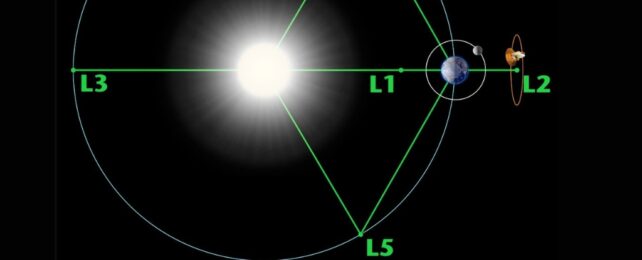A new 'space race' is heating up between the US and China in space exploration, and Lagrange points are emerging as a battleground.
Named after the astronomer Joseph-Louis Lagrange, they are locations in interplanetary space where the gravitational pull of two celestial bodies (like the Earth and the Sun) balances the centripetal force needed for a smaller object to orbit steadily between them.
There are five different Lagrange points in the Sun and Earth-Moon system, labeled L1 to L5, that result from these unique points of interaction with gravity.
L4 and L5 are nestled at fixed positions 60 degrees ahead and behind Earth (plus Moon) on its orbital path around the Sun. This stability makes them ideal 'parking' spots for satellites and telescopes.
Spacecraft can stay put at these zones for a long time without needing much fuel to adjust their position, offering a continuous view of our planet and its natural satellite and an ideal point for observing Earth's weather patterns.
The lack of atmospheric interference and proximity of L1 and L2 to the Moon make those locations popular parking spots as well. Whoever controls these positions has a significant advantage when it comes to space research, communications, and surveillance.
From the Sun's point of view, L2 is 1.5 million kilometers (932,000 miles) 'behind' Earth. It orbits the Sun at the same speed as Earth, but at approximately four times as far away from us as the Moon ever gets.
Behind the Moon from Earth's perspective, L2 provides an unobstructed view of deep space, making it an ideal location for sensitive telescopes like JWST.
China has already sent the Queqiao relay satellite to L2 in the Earth-Moon system for communication from the Chang'e 4 lunar probe, the first to land on the far side of the Moon.
The US has its sights set on Earth-Moon system L2 as well, with missions like the Gateway lunar outpost planned for the late 2020s.
"L2 is specifically important because of its visibility to the far side of the Moon," space systems engineer Laura Duffy told Eric Berger at Ars Technica. "We cannot see that from the Earth, and China is headed there."

US-China economic and technological rivalry was the subject of a recent report by a House of Representatives bipartisan committee that sought to "fundamentally reset" the relationship through nearly 150 policy recommendations.
The report is the result of an investigation that had been underway for a year into the rivalry between the nations ever since China's 2001 entry into the World Trade Organization.
"NASA and relevant Department of Defense funding is critical to ensure command and control in the space domain," the report states, "establish dominance in multilateral space governance, and spur scientific discovery and American innovation."
The areas covered by the recommendations are extensive, but one suggestion regarding space stood out. Specifically, according to the report, Congress should:
"Fund NASA's and the Department of Defense's programs that are critical to countering the CCP's [Chinese Communist Party] malign ambitions in space, including by ensuring the United States is the first country to permanently station assets at all Lagrange Points."
In the last few years, China's space program has come a long way. The Chang'e 5 lunar sample return mission and the upcoming Chang'e 6 mission to the Moon's south pole are two examples of their big steps forward.
Tiangong, China's space station, is up and running, and they hope to dispatch taikonauts (astronauts) to the Moon in the not so distant future.
"The CCP understands well the need for space-based operations and is developing formidable space capabilities to challenge US dominance in this domain," the committee report says.
Both countries are also developing technologies for deep-space exploration, with Earth-Moon system Lagrange points offering stepping stones for future missions to Mars and beyond.
Besides competition between the US and China in space exploration, there's also collaboration between many countries on projects like the International Space Station, that continues to advance our understanding of the Universe.
The international community has an interest in Lagrange points too, with organizations like the European Space Agency developing their own missions to these strategic locations.
The new space race's focus on Lagrange points is perhaps as troubling as it is fascinating, though will at least be interesting to see how they're used to push space exploration forward.
